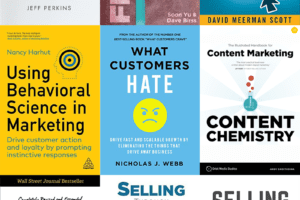???? Episode 72 of Yes, and Marketing
What if we stopped viewing content as a funnel?
Ashley Faus shares a new way to think about content in her conversation with Steve on this episode of Yes, and Marketing. As content strategy lead at Atlassian and one of the top B2B marketers to follow today, Ashley combines deep, in-the-trenches insight with experience and examples from her vast array of personal interests (from musical theater to pistol squats) for a conversation every content marketer should hear:
- What people get wrong about personal branding
- The 4 pillars of thought leadership, and the 2 most common misconceptions about it
- Her biggest lesson from acting that serves her as a marketer
- Why marketing is *not* her life’s purpose
Tap through the chapters above to listen or read on for our highlights from the episode. Want to watch the whole interview? Find it on our podcast page.
???? Who is Ashley Faus?
Name: Ashley Faus
What she does: Content strategy lead at Atlassian.
Find Ashley on the web: Atlassian | LinkedIn | Twitter
Get smart: “As a marketer, we need to create a journey that’s so smart and so connected that people can go up down and sideways and they can use content in the wrong way.”
???? Top Takeaways
Humans don’t fit into a linear funnel
The typical marketer views content as a funnel: Top-of-funnel content provides awareness of the problem, middle-of-funnel content leads to the consideration of a particular solution, and bottom-of-funnel content looks at details like pricing. In this model, prospects move in a linear fashion through the stages of learning about a problem, thinking about solutions, and being ready to buy.
The problem with that? “Most people intuitively understand that they don’t go in a linear fashion,” Ashley says. “They go up, down, sideways, they enter, they exit. They’re in a mindset of buying, they’re in a mindset of learning, they’re in a mindset of eating ice cream on the couch, which does not fit into our linear funnel.”
What we need to do instead, she explains, is think about content as a playground, which allows different people to use it in different ways.
“If you think about a playground, what’s the right way to play on the playground?” she asks. “Is it to go slides and then swing, and then merry-go-round? Is it to skip the merry-go-round altogether? And what about the people who are sitting on the park bench—are they using the space in the wrong way?”
This approach allows for the fact that your audience is made up of humans with their own unique lives and interests, not prospects following an identical, regimented path.
“If we think about this as a marketer,” she adds, “we need to create a journey that’s so smart and so connected that people can go up down and sideways and they can use content in the wrong way.”
The three depths of content
As part of her content framework, Ashley thinks about three different depths of content based on how each piece helps the reader. She explains:
- The conceptual level: “This is really helping people frame up the problem and thinking about the what and the why of the idea.”
- The strategic level: “This is helping people think about solutions—not necessarily just the solution that you provide but all possible solutions—and the key processes, knowledge, components, and tools that you need to make the solution a reality. And it’s equipping them to do their own research.”
- The tactical level: “This is where you get nitty gritty, prescriptive, step-by-step instructions for the daily habits or daily tools that you would be using.”
The important thing about these levels are that they’re connected, but they don’t have to flow linearly. “It doesn’t matter which thing you start with, or whether you go up to conceptual or down to tactical, if you’ve landed in strategic,” Ashley explains. These levels meet prospects where they are and allow them to create their own journey through your content playground.
???? Episode Highlights
One lesson from the stage that makes her a better marketer ????
“As a performer, you’re constantly having to step into someone else’s shoes. You have to walk like them. You have to talk like them…
That ability to context switch and to try on these different life stories, these different physical movements, these different ways of thinking in a three-hour period—I think that really gives me, from a marketing standpoint, an appreciation for the whole human that a lot of people approach as, ‘Oh, is this person a prospect? Is this person a user? Is this person a stakeholder?’ But at the end of the day, they’re a person.”
How she approaches personal branding
“On the personal branding front, when you start to dig in and ask someone, ‘What do you like to wear? How do you speak? How open are you?’ And they reply like, ‘Oh, I’ll just do whatever you tell me.’
And I’m like, ‘No, no, no. There’s not a right answer here. There’s not a brand of you that I’m trying to craft. That’s not what we’re trying to do. We’re trying to uncover who you actually are and which elements of yourself you want to share more publicly.’”
An example of the funnel’s limitations
“If you look at something like pricing, that is traditionally considered a ‘bottom of funnel’ piece of content. ‘Oh, if they’re looking at pricing, then 100% they are ready to buy. Let’s sell ’em something.’
An example I give is a couple years ago my boss came to me and said, ‘Hey, we’re looking at solving this problem. We want to buy software. How much budget should I ask for?’ And I have no idea how much budget to ask for, so I start Googling around. I find the big players in the space and I say, ‘Hey, I’m trying to secure a budget. What is the cost at this SLA for this many licenses?’ And the number of sales reps that came back to me and said, ‘Oh, you need to download this white paper. Oh, you need to book a whole demo.’ And I’m like, ‘…I don’t even have a budget yet.’”
The problem with MQLs
“There’s this mindset that you’re not even in the funnel or not even a prospect until you’ve done these certain steps in this certain order. For a lot of demand gen professionals, this is the marketing qualified lead or the MQL: ‘We gotta score you. And if we can’t score you, then you just don’t exist.’”
An example of content depths in action ????
“If you ask the question, ‘What does it mean to be healthy and fit?’ Most people would say it’s some combination of diet and exercise. But you’re gonna answer that question very differently if you’re a Runner’s World versus Yoga Journal versus Muscle & Fitness.
Let’s say we’re gonna answer these questions as Muscle & Fitness. At a conceptual level, you would say you’re healthy and fit if you eat a high protein diet and you have big, strong muscles. At the strategic level, this is where you might talk about the value of compound lifts or how to have good form when you’re lifting, and then the differences between fast digesting and slow digesting protein for your recovery. And at the tactical level, this is where you get ‘Five chicken dinners to eat this week’ or ’10 tips to build bigger biceps.’ And so when you realize that you could start with ’10 tips to build bigger biceps’—why do I need bigger biceps?
‘Well, if you jump up to the conceptual level you’ll find out that if you have big biceps that makes you healthy and fit because you have big, strong muscles.’
Or if you say, ‘Okay, well, now that I know I need to have big, strong muscles, how else do I get big, strong muscles?’
‘Well, you need to be eating the right diet, and so if you look at these different types of protein, you’ll see that those are better for different muscle recovery elements.’
…You realize it doesn’t matter which thing you start with, or whether you go up to conceptual or down to tactical, if you’ve landed in strategic. They’re all connected.”
Why a content audit is never done
“I don’t think that there is a destination, like ‘Great. We finished the content audit. We sunsetted however many pages or redirected so many pages.’ Cool. In that time, additional content got created because we brought new products online or we sunsetted a product, and we shifted our messaging to be 100% this ‘cloud first’ mindset.”
The two things people get wrong about thought leadership:
“First, that it has to be an executive or a founder or a C suite person—that the person who is the thought leader in the company has this big fancy title. …The second thing is that thought leadership equals sales.”
Her four pillar framework for thought leadership
- “There’s the credibility piece where people have to believe that you know what the heck you’re talking about and a title can be a proxy for that, depending on what it is.”
- “Then there is profile. So this is, how well known are you and what is the nature of the people that know you?”
- “Next is prolific. So this is how often are you writing, speaking, sharing, codifying things and giving them out to the world in the different types of channels?”
- “Fourth thing is depth of ideas. This is a huge misconception because people think that if you’re good at your job, that means that you’re a thought leader. That is not true. The key is that you’re sharing externally and you’re codifying that information in a way that someone else could follow it, implement it, build on it.”
How the pillars work in tandem ????️
“If you’re not codifying it, you’re not gonna have anything to share, which is why you’re struggling to be prolific. If you’re not sharing, you’re not gonna be able to build a profile because no one knows who you are. If you’re out there and you’re sharing a bunch of stuff, but it’s stupid—it doesn’t have that depth of ideas—nobody thinks you have credibility and so they’re not gonna listen to you. So they have to work in tandem.”
More than a marketer
“I did a Q&A with some high schoolers years ago. And they were like, ‘How did you know that marketing was your purpose?’ I was like, ‘I’m gonna stop you right there—marketing is not my purpose.’ You don’t have to pick something when you’re 18 years old and be married to it for life.”
????️ Ashley Faus Quotes
“Marketing is about understanding problems and understanding solutions and matching those two things.”
“Anyone that declares themselves as a thought leader is probably not a thought leader.”
“As a marketer, we need to create a journey that’s so smart and so connected that people can go up down and sideways and they can use content in the wrong way.”
“Executives—they’re great at running the business, but they don’t have time or head space to actually codify what they’re doing tactically, strategically, or from a vision standpoint such that someone else could implement it.”



